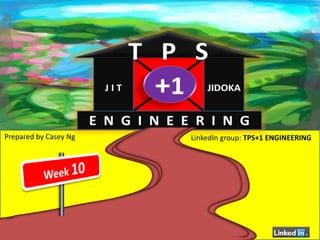Tps+1 engineering wkly-working10
- 1. Prepared by Casey Ng LinkedIn group: TPS+1 ENGINEERING
- 2. TPS+1 ENGINEERING group is an active discussion group in LinkedIn of TPS practitioners in strategic planning , product planning, cost planning, purchasing, training, IT development and engineering including new application development, pioneering application for other industries such as health care, servicing, mining, logistic and others The concept of TPS+1 is building on the evolving development of TPS that the current stage of TPS is TPS of previous stage + added elements, therefore, it is continually TPS=TPS+1
- 3. 25th Feb to 3rd Mar 2103 Most popular discussions Standards should be checked and changed on a regular basis. depending on the process perhaps once a year is sufficient ˇ The perfect standard will never exist, as everything is evolving. ˇ standard that has not been changed in a year means little Kaizen is happening.. Standard work has three fundamental purposes: 1. training new employees, 2. problem solving, 3. continuous improvement. Therefore, each time there is a new employee or a new problem, the standard should be challenged and improved,.. a critical pause to ask the question what have we learned about the task and the work we do to accomplish the task is appropriate. .. Good S/W will give you the traceability required should defects be produced in the production/manufacturing process. I am not satisfied if I come back from genba without had heard any new idea or had seen an improvement. "Change is the only constant". CHANGE and CHARGE!!!
- 4. The most frequent reason to improve the standard document is to better describe the way of doing the task (adapt wording, photos...). One has to remember one of the purpose of the standard work sheet as supporting material for new comer training. To adapt an English say about apples and doctors ... One audit a day keeps the trouble at bay! I challenge everything and often. I want to know (5) Why on any process I observe. Goodyear Tire Co. once boxed up every tire individually and stacked onto a pallet; nobody knew why. After research, they concluded it was to protect the white wall of the tires. That process was created in the 50's and was no longer relevant to today's trends. Standards are only as accurate as the day they are created. So, if we consider that we are in constant "process improvement", which is equivalent to the constant "performance enhancement", we make constant revisions of the standards.. Here is the word play. Could we extend the idea from zero inventory to A mental Challenge for all in this thread negative inventory to other areas? How about Why is the third statement true? from zero defects to negative defects? Or zero accidents? How about negative accidents? A 1. When work is performed in the absence of a standard, this is workplace that actually heals the sick and makes an abnormality healthy people healthier, because it is closer to 2. When standards exist but are not being followed, this is an the ideal process. Now that's something that abnormality makes doing kaizen for the rest of our lives 3. When standards exist and are being followed, this is an worthwhile. abnormality "Without Standards, there can not be Kaizen!" Taiichi Ohno So what's the benchmark for an updated and optimal Pencils and Paper are a humble couple. Lamination sheets, standards? computers, and pens are an arrogant family of concrete heads ;-)
- 5. 4th Mar to 10th Mar 2103 New discussions JIDOKA, NDC and QUALITY 1 2 3
- 6. MONOZUKURI ¤â¤Î¤ş¤Ż¤ę Ł´ PERSONAL AND MANAGEMENT PRACTICE 5
- 7. IMPLEMENTATION 6 HEIJUNKA Ć˝śĘ»Ż 7
- 8. TOYOTA and IT Systems 8 ISO and VISUAL MANAGEMENT 9
- 9. DEBATE 10 JIT 11








